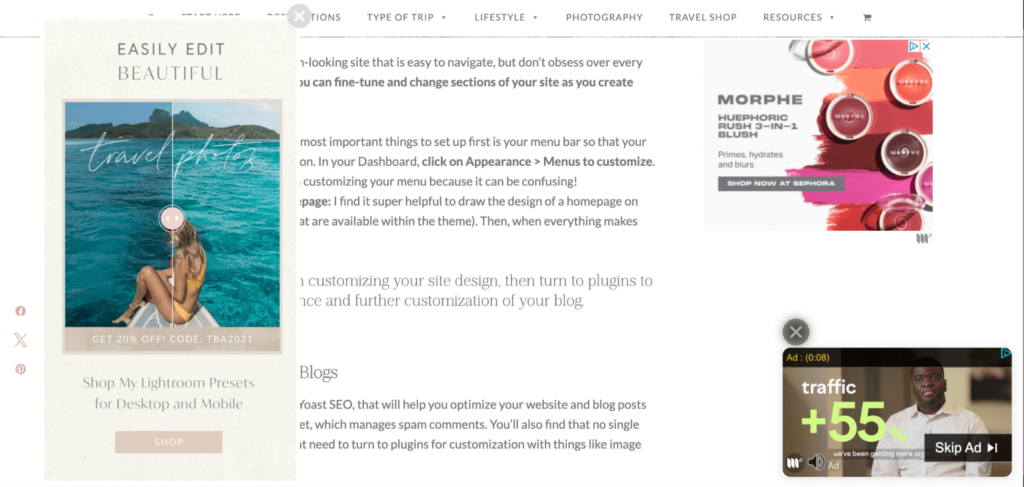Imagine waking up to the sound of your phone buzzing – not with social media notifications, but with sales from your latest ebook. Exciting, right? Digital products let you turn your travel smarts into a steady stream of income, all without the hassle of inventory and shipping.
If you’re a blogger looking to add digital products to your toolbox, you’re in the right place. This article covers everything you need to know, from brainstorming the perfect product idea to creating digital products and promoting your product offering online.
What is a digital product?
Digital products are non-physical assets that can be sold online. Unlike traditional products, they don’t require inventory, shipping, or physical storage, making them highly scalable and cost-effective.
Digital products include ebooks and audiobooks, online courses, personalized itineraries, printable travel journals, and other formats.

For some inspiration, let’s take a quick look at some examples of creators out there killing it with their digital products:
- Katie and Ben from Two Wandering Soles created a course called “Van Conversion Academy.” It provides detailed instructions on converting a van, from properly installing an electrical system to keeping everything under budget.
- Nicole Nagelgast, the creator of The Adventure Book, offers a range of journals designed to help travelers document their journeys. The “Ultimate Traveler’s Edition” includes spots for the world’s 196 independent countries and 69 additional territories, plus fun challenges and maps to color in.
- Kiersten Rich, aka The Blonde Abroad, offers a comprehensive collection of Lightroom presets to enhance photos. Her presets are grouped into various collections such as “Fire & Ice,” “Jungle Vibes,” “Moroccan Oasis,” “Tropical Escape,” and “Into the Wild.”
What advantages do digital products have for travel bloggers?
Digital products:
- Can be sold an unlimited number of times without additional production costs.
- Help bloggers showcase their expertise and build credibility in their niche.
- Allow content creators to monetize their knowledge while continuing to explore the world.
- Give bloggers another place to put affiliate links, helping them earn additional passive income and achieve financial freedom and flexibility.
Join the Travelpayouts partnership platform
Streamline your travel blog's financial success.
Join todayHow to create a digital product
Ready to turn your travel expertise into a money-making machine? Remember, even the longest journey starts with a single click. So, let’s dive in, starting with how to make digital products.
Choosing which product to offer
Would you bring soup on a road trip? Would you bring stinky cheese to a potluck? Would you try to sell guides to Greenland to an audience that’s interested in Ibiza? When choosing a digital product, think above all about what your audience will enjoy and find useful. Conduct surveys or polls to understand what they’re looking for. For instance, if your readers are interested in cheap travel, consider creating ebooks or guides that offer detailed budget itineraries.
Think about:
- What you can offer
- How much time you can spare
- What your audience is interested in
- The potential profit

For example, if you’re a travel photographer with a knack for capturing breathtaking landscapes, an online course on travel photography could be your golden ticket. But if you don’t have the time to create a course from scratch, you can opt to sell photography presets for Lightroom that you already use and love.
Want some more ideas? There’s an article for that 👇
The creation process
Creating digital products involves several key steps:
- Plan your product: For example, create an outline of your product for an ebook and list chapters and key points. For an online course, outline modules and lessons. This ensures you’ll cover all necessary information in a structured way.
- Create the content: Start writing, recording, or designing your product. Use the best tools and software your budget allows. For ebooks, tools like Scrivener or Google Docs are helpful. For online courses, consider platforms like Thinkific or Udemy.
- Edit and proofread: Ensure your content is error-free and polished. Consider hiring a professional editor for ebooks or a video editor for online courses.
- Design professional graphics: Attractive covers and graphics can enhance your product’s appeal. Use tools like Canva or hire a graphic designer to create professional-looking visuals.
Wondering how to create digital products with specific tools and services? Check out our article 👇
Practical tips for creating quality products
Creating digital products can be a rewarding process if done right. Here are some practical tips to make sure your work shines:
- Deliver value: Make sure your product solves a problem or meets your audience’s need. Good content should offer actionable tips and real value.
- Invest in professional design: A great design makes your product more appealing. Use tools like Canva for eye-catching graphics, or hire a designer to give it a professional look.
- Beta testing: Before launching, get feedback from a small group of your target audience. Platforms like SurveyMonkey can help you collect and analyze feedback efficiently.
- Iterate based on feedback: Refine your product based on the feedback you receive so you can better meet your audience’s needs.
How to market digital products
To make money from your digital products, focus on engaging your target audience and building trust. Here are some proven strategies to help you succeed.
Use social media marketing


Use platforms like Instagram, Facebook, and Pinterest to showcase your products, share user-generated content, and engage with your audience.
For example, you can share high-quality images and stories on Instagram using the Shopping features and influencer collaborations.
Optimize your website for SEO
Optimize your content for search engines to improve your site’s visibility and attract more organic traffic.
- Keyword research: Identify relevant keywords and incorporate them naturally into your content. Tools like Google Keyword Planner can help you find the best keywords to target.
- Quality content: Create informative and engaging content that answers your audience’s questions and provides value. This builds trust and encourages repeat visits.
- On-page SEO: Ensure your website is optimized for SEO by using appropriate meta tags, alt text for images, and a clean URL structure.
Leverage email marketing
Build an email list and use it to keep your audience informed about new products, special offers, and valuable content.
- Lead magnets: Offer free resources like ebooks or guides in exchange for email sign-ups. This helps you grow your mailing list.
- Segmented campaigns: Tailor your emails to different audience segments based on their interests and purchasing behavior.
- Automated drip campaigns: Set up automated email sequences to nurture leads and convert them into paying customers.
This just scratches the surface of what you can do to market your digital products. More info about marketing here 👇
Selling your digital product
You’ve put in a lot of work, but how do you actually sell your digital product online? Let’s make sure your masterpiece doesn’t just gather digital dust. Here’s how to get it in front of the right audience and start making those sales.
Choosing the best platform
The best way to sell digital downloads depends on your needs. Here are a few things you should take into account:
- Ease of use: The platform should be user-friendly. Gumroad is a great example of a platform known for its simplicity and intuitive interfaces.
- Secure payments: Your customers need to be able to trust that their payment information is safe and that they’ll receive their purchase without hassle. Use reputable payment gateways like Stripe or PayPal that offer robust security measures like encryption and fraud protection.
- Delivery mechanism: Platforms like SendOwl automate this process, ensuring customers receive their downloads immediately after purchase. This helps maintain customer satisfaction and trust.
- Marketing and promotion tools: Choose a platform that offers built-in marketing tools such as email campaigns, discount codes, and affiliate programs.
- Customization and branding: It’s important to be able to customize your storefront to match your brand. Platforms like Payhip offer extensive customization options. A consistent look builds trust, increasing customer confidence and conversion rates.
- Scalability: As your business grows, your platform should scale with you. Thinkific and Kajabi offer scalable plans to accommodate your expanding needs, from handling more products to providing advanced features.
Find the best platforms for your digital products 👇
Pricing strategies
Pricing your digital products can feel like walking a tightrope – you don’t want to undervalue your work, but you want to attract buyers. Here are some tips to help get it right:
- Competitive pricing: Research similar products in your niche and price your product competitively. Ensure your price reflects the value and uniqueness of your offering (too low might seem suspicious!).
- Tiered pricing: Offer different pricing tiers for various access levels, bundles, or additional features. This can cater to different segments of your audience and maximize sales.
- Discounts and promotions: Run limited-time discounts and promotions to create urgency and attract new customers. Use tools like coupon codes to make this process seamless.
Tracking and analyzing performance
Now, the hard part: do you know what is and isn’t working? You need to keep an eye on your data so you know whether people are buying your digital products and what’s hitting the mark.
Start with the built-in analytics tools your selling platform offers. For example, Gumroad provides detailed insights into sales, customer behavior, and revenue trends, letting you see what’s flying off the virtual shelves.
Integrating Google Analytics into your website can give you even deeper insights into where your traffic is coming from, how users are behaving, and what the effect is on your conversion rates.
Qualitative data is important, too. Use surveys, reviews, and direct feedback to determine what your customers love and what needs improvement.
Is it worth creating and selling digital products?
Don’t take our word for it. Let’s see what other creators have to say about creating digital products:

Sarah Chant, New Zeland Travel Tips, Building Better Groups, Global Travel Tips
“I sell travel guides for New Zealand (and now courses about Facebook groups and monetization). They’re all listed on my website, but most of my sales come through my Facebook Groups.
I don’t have a fancy sales funnel (though I probably should), so I just introduce my email list (in one email) to what we offer regarding downloads. As I say, though, most sales come through our groups.
I just checked, and we sold just over $20k in the last year. It was well and truly worth the time I put into them (though also nowhere near our most profitable action), plus you’ll likely increase affiliate sales.”
Mince Solahudin:
“They will buy an experience, a personal, unique route/itinerary, the best savings recommendation, a quicker route to a destination, affordable restaurants, entertainment, and accommodation – something that Google does not offer. Most loyal buyers have followed the story via blog or have already built trust with the author.”
Cristina, Honest Travel Stories:
“I have two guides that I sell mainly through my blog and a bit on Etsy (Etsy is shamelessly ignored, though I haven’t done anything in a year or more).
They sell – not amazingly, as I don’t do a great job promoting them and mostly rely on automation. For the work that I’ve done, I think the ROI is okay.
But their lifetime value is higher, as I have affiliate links for them, and they convert. So even if I don’t price them very high, the value I get is decent.”
Leap digital products
Creating digital products helps you turn your travel passion into a goldmine. Explore the many possibilities they offer, and to get even more bucks for your effort, join Travelpayouts. Adding affiliate links to your products can earn extra cash while helping your audience discover great travel deals.
Travelpayouts even has a Chrome extension that lets you add partner links to your posts right from your browser – streamlined to the gills! Find out more about how this tool can make your affiliate marketing easier and more profitable in this article.
Happy creating <3




